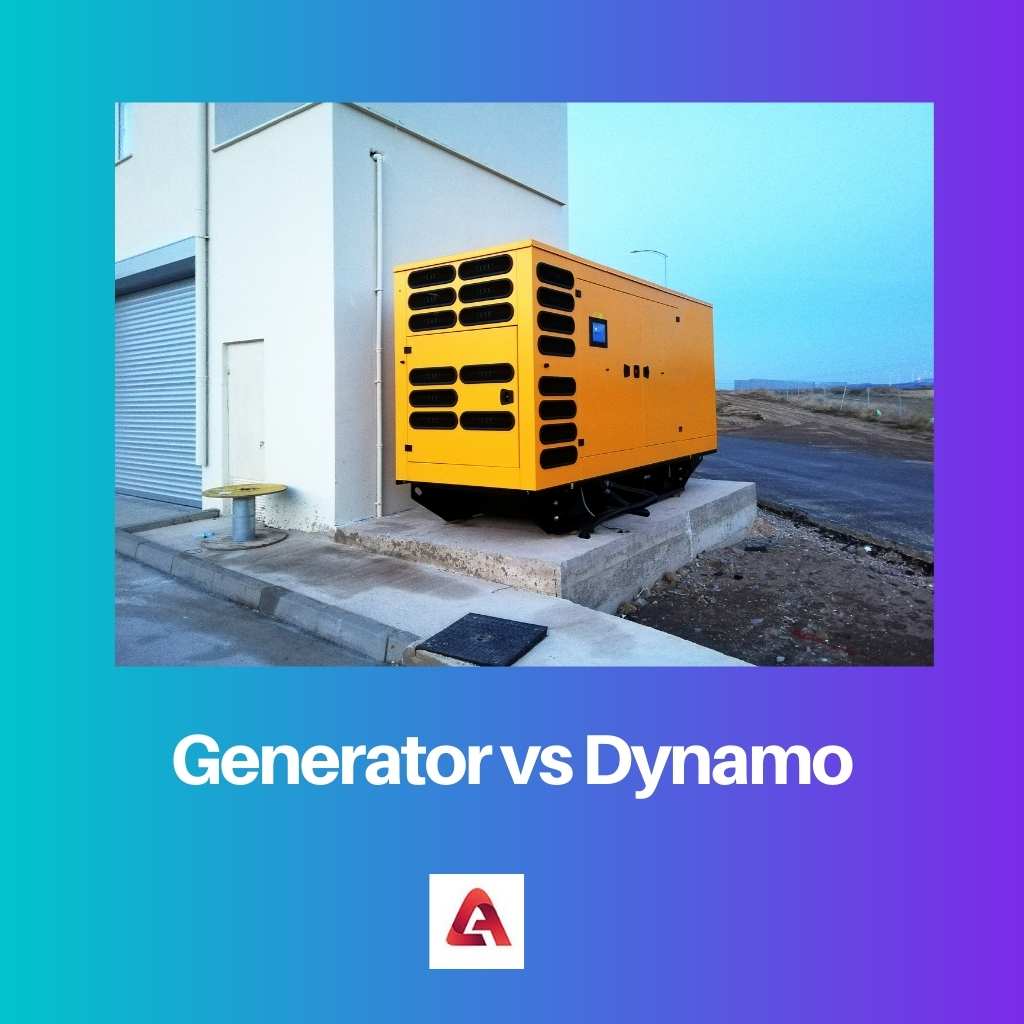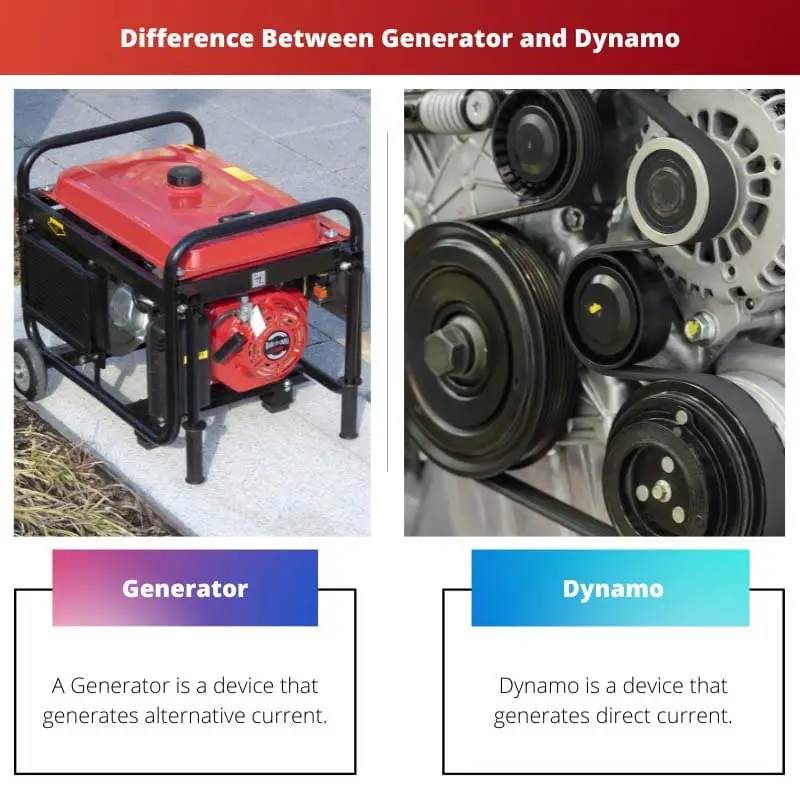Earlier, batteries were the first to facilitate the generation of electricity however, when scientists experimented to check the reliability of the battery, they found that batteries were costly for everyday human use.
After that, Dynamo came which was further improved into a more reliable device named Generator.
Key Takeaways
- Generators convert mechanical energy into electrical energy, while dynamos are generators that specifically produce direct current (DC) electricity.
- Generators are used in various applications, from large-scale power plants to small portable devices, while dynamos were historically used in early power generation systems and some small-scale applications.
- Both generators and dynamos work on the principle of electromagnetic induction but have different designs and output characteristics.
Generator vs Dynamo
A generator is a machine that converts mechanical energy into electrical energy by electromagnetic induction. Generators are used to produce electricity in power plants. A dynamo is an older type of generator that produces direct current (DC) electricity through the use of a commutator.

A Generator is an electrical device that generates alternative current and it further helps in supplying current to various other appliances which work on electricity.
Power output with a wide range, multiple fuel usage, portability, are some of the features of the generator. The Generator acts as a backbone for providing uninterrupted electricity.
Dynamo is an electrical device that generates a direct current. It consists of three components, Stator, Armature, and Commutator which helps it to work.
Dynamo is also called the first generator in work, to provide continuous electricity supply. However, earlier it was also known as a generator.
Comparison Table
| Parameter of Comparison | Generator | Dynamo |
|---|---|---|
| Meaning | A Generator is a device that generates alternative current. | Dynamo is a device that generates direct current. |
| Supply of current | Alternative current | Direct current |
| Energy conversion | Mechanical energy into Electrical energy | Electrical energy into Mechanical energy |
| Working principle | Principle of Faraday | Principle of Production of dynamically induced |
| Range of Rotations Per Minute (RPM) | Supports 1800-3600 RPM | Supports 1000-2000 RPM |
| Uses | The Power station, Vehicles, Human-powered electrical generators, Mechanical measurement | The Power station, Low power applications, Clockwork, Radio, Hand powered flashlights, Human-powered equipment |
What is a Generator?
A Generator is an electrical appliance that generates alternative current by converting mechanical energy into electrical energy through the process of electromagnetism.
It was invented by Michael Faraday and Joseph Henry in the 1820s and was further developed by others.
It consists of a Rotor, which is the rotating part of the machine, and, Stator, the stationary part surrounding the rotor.
The Generator works on the principle of Faraday under the law of electromagnetic induction where a conductor coil, made up of copper rotates promptly, through a Rotor,
between the permanent magnet whose one side is connected to one ring and the other side with another one of the Commutator, thus making the output current flow into a wave-like direction or in an alternate way,
known as the alternative current. Therefore, in such a way, a generator works.
There are two types of generators, AC generator, which converts mechanical energy into alternate electrical energy, and DC generator which converts mechanical energy into direct electrical energy.
The design of a generator still keeps on improving thanks to the research in this field due to its continuous popularity. Some of the specialized generators are the Homopolar Generator,
Induction Generator, Linear Electric Generator, and some others.

What is a Dynamo?
The word ‘dynamo’ was coined by Michael Faraday in 1831 while the first dynamo was invented in 1832 by Hippolyte Pixii of France.
Dynamo is an electrical appliance that generates direct current by converting electrical energy into mechanical energy through the process of electromagnetism.
The principle of production of dynamically induced under the law of electromagnetic induction makes the dynamo work properly.
The working mechanism of a dynamo is such as between a permanent magnet, there is a certain magnetic force known as magnetic flux where a copper wire called coil keeps on rotating
may be due to the attraction between the two opposite poles of the magnet or due to any human interference. This coil is attached to a commutator where there is a brush on the side.
This brush may be further connected to any object which needs electricity.
The current generated here is known as induced current thus cutting through the magnetic flux and this act can be seen through the fluctuation occurring in the galvanometer.
The output which generates is known as direct current, stating the working mechanism of a dynamo.
However, as dynamo supplied direct current it had to be located near the object due to which it came on the verge of being extinct.

Main Differences Between Generator and Dynamo
Both generator and dynamo help in generating electricity, however, there are certain differences between them.
- Generator deals with the generation of alternate current, changing its direction continuously. On the other hand, Dynamo deals with the generation of direct current, thus flowing in one constant direction.
- The Generator converts mechanical energy into electrical energy whereas, Dynamo converts electrical energy into mechanical energy.
- The Generator works on the principle of faraday while Dynamo works on the principle of production of dynamically induced, both under the law of electromagnetic induction.
- Generators support the range of rotations per minute between 1800-3600 whereas between 1000-2000 is the range of rotations per minute of Dynamo.
- The use of a generator can be seen in Power station, Vehicles, Human-powered electrical generators, Mechanical measurement while Power station, Low power applications, Clockwork, Radio, Hand powered flashlights, Human-powered equipment facilitates the use of Dynamo.

References
- https://ieeexplore.ieee.org/abstract/document/7911104/
- https://books.google.com/books?hl=en&lr=&id=lhNDAAAAIAAJ&oi=fnd&pg=PA1&dq=electric+dynamo&ots=ZhZRl8Ld47&sig=SVfFN0jNIpfnZC6TJoAsu0FOPLk
